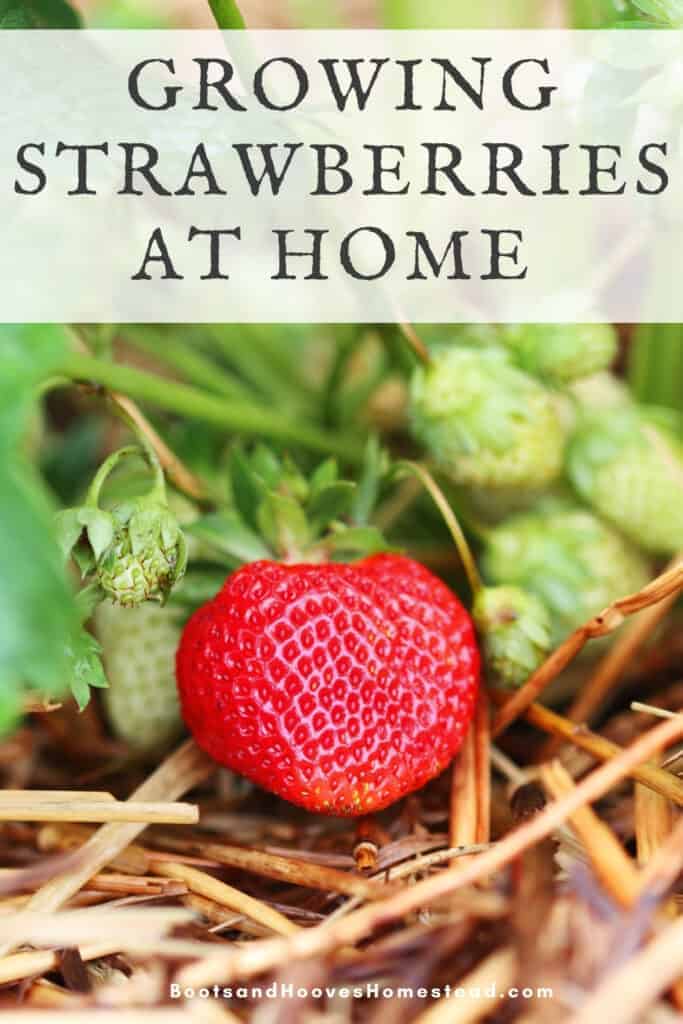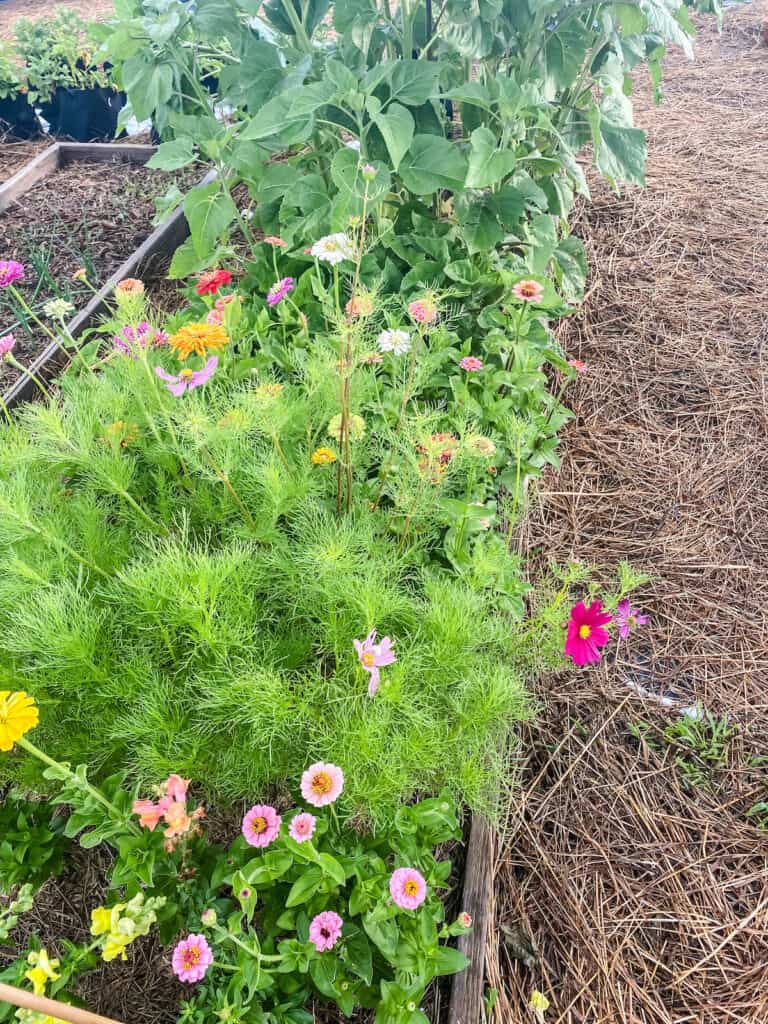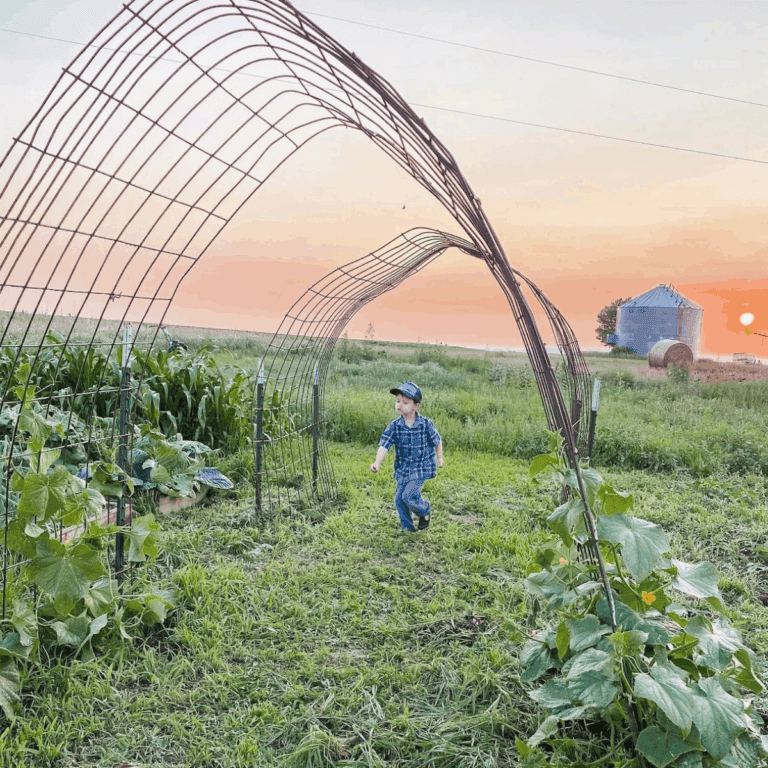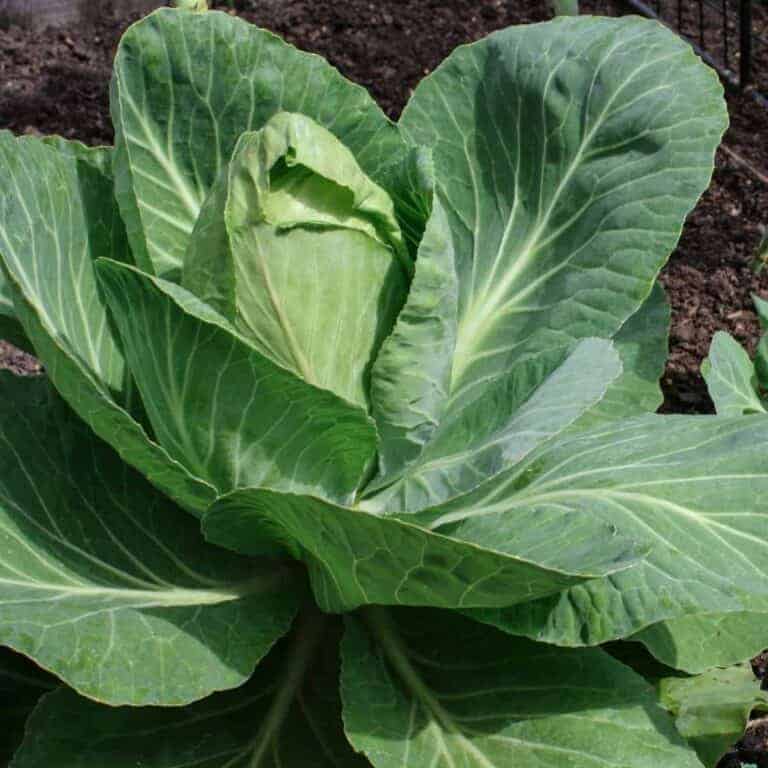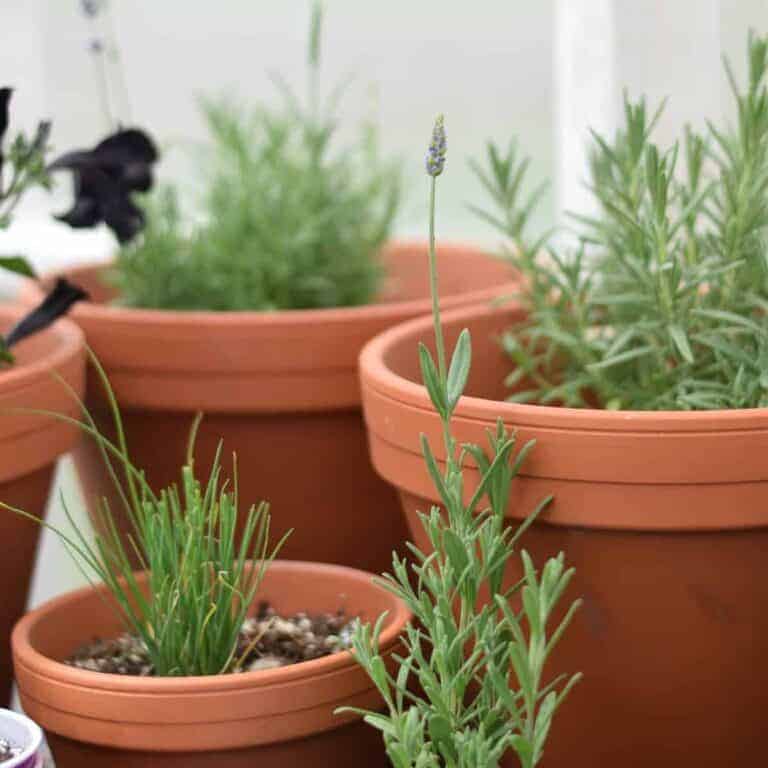Tips for Growing Strawberries + How to Grow in Raised Beds
In this post, I’m sharing our best tips for growing strawberries at home and how to grow delicious berries in raised beds.
Growing strawberries at home is a fun and rewarding hobby that home gardeners in almost every temperate growing zone enjoys. The sweet, red berries are a favorite for people of all ages.
Strawberries make an excellent choice to grow in the kitchen garden. And they are a favorite for children’s gardens too!
Our children love to harvest fresh berries all season long and so we’ve added multiple strawberry garden beds throughout the garden.

This post has been updated from the original publish date of April 3, 2021 to provide additional helpful information.
How to grow strawberries in raised beds
Growing strawberries in a raised bed can be a great way to ensure good drainage and soil quality for your plants.
You can grow strawberries the same way you grow any crop, really! With the right organic materials, time, effort and conditions, in a few weeks you will have the reward of a crop of strawberries.
The ideal time to plant new plants is in fall or early spring, as they do best in the moderate temperatures.
If you have a smaller garden space, consider growing strawberries in containers. This is another convenient and great option. Choose a pot that is at least 10 inches wide and fill it with well-drained soil.
A light colored pot will also help the plant to stay cool in the summertime. One that is wide and shallow can be the best option, or one that has plenty of drainage.
Those with limited growing space will also benefit from growing their plants vertically with a garden tower.
Planting bare root strawberry plants correctly is important to helping them grow their best. Put them in soil after all chances of frost have passed.
Plant them with a mixture of potting soil and fertilizer, such as compost. Dig it in a hole at least the length of the root and twice as wide. After planting, mulch and water in. They will begin to leaf by early summer.
Harvest ripe strawberries as soon as they are ready – the berries that are completely red. Gently lift the fruit from the plant, being careful not to damage the stems or nearby fruits.
Pick them off of the plant every few days. Grasp the ripe fruit with your hands, and pull the berry off the stem.
Enjoy your homegrown strawberries fresh or use them in various culinary creations like this summer berry trifle!

Step-by-step guide to growing strawberries in a raised bed:
Choose a Suitable Location: Select a location for your raised bed that receives at least 6-8 hours of direct sunlight per day. Ensure there is good air circulation to prevent diseases. Powdery mildew, root rot, leaf scorch, and leaf spot are common diseases that strawberry plants can experience.
Build or Prepare the Raised Bed: Construct a raised bed using untreated wood, composite material, or other suitable materials. Ensure it’s at least 8-12 inches deep to accommodate the strawberry roots. If you’re using existing raised beds, ensure they are clean and free from any debris.
We love using these metal raised beds in our garden and have multiple beds of asparagus and strawberries growing together.

Are strawberries an annual or perennial plants?
Strawberries, like other berry plants and bushes, are perennials. If you leave the root systems intact, they will grow back.
Proper care should be taken to protect the plants from frost, as well as adapting a fertilizing and watering schedule to help them be strong and vibrant year after year.
Some plants bear fruit for three weeks in the spring, and others are “ever bearing” with smaller harvests throughout the growing season.
A plant that is taken care of will return for three to five years, give or take.
Select the right strawberry varieties
Choose the types of strawberries that are suitable for your climate and growing conditions. Check your growing zone for the best strawberry variety to choose for your area.
Day-neutral or everbearing varieties are often preferred for their continuous fruiting throughout the growing season. Pair these with June-bearing strawberries and you’ll have a nice solid harvest all through the growing season.
You can easily start your strawberry patch with plants from the garden center or grocery store. Azure standard also has excellent organic strawberry plant starts available in both everbearing and June-bearing varieties.
Want to save this?
However, I recommend getting started with bare root strawberries. Bare-root plants usually come in packs of 25 and you’ll be able to get more bang for your buck.
Bare roots are my favorite option for getting a large amount of plants to grow without breaking the bank.
You could also grow strawberries easily from seed, too.
How long does a strawberry take to grow
A seedling will turn into a full plant from about six months after planting the seed. After the dormancy period, a strawberry plant will take about 2 months to produce fruit from a flower.
Many gardeners see that raised beds are ideal for growing strawberries. The raised bed design holds water and nutrients, and they are also easy to amend when in a controlled raised bed design.
A tip for gardeners, especially in areas where there is wildlife, is to put some kind of barrier around the berries so wild creatures do not get a chance to eat the berries before you do!
Other than that, it takes a dedicated water regime, proper spacing, nutrition, and patience.

Growing conditions
The best type of soil for growing strawberries is sandy loam soil with plenty of organic matter. They prefer areas that are not too wet, so avoid planting strawberries in areas that are too moist during the spring. The right soil conditions is between 5.5 and 6.8 pH.
Ideally, the temperature range for growing strawberries should be between 50 F and 80 F. They are sensitive to frost, and will wither in higher temperatures, so this is the right temperature for them.
Strawberries need at least 8 hours of sunlight a day, so full sun or partial sun will help them grow their best.
Preparing the soil & planting tips
Fill the raised bed with a well-draining, fertile soil mix. A good mix may include equal parts of garden soil, compost, and perlite or vermiculite for improved drainage.
Ensure the soil pH is between 5.5 and 6.5, as strawberries prefer slightly acidic soil. You can check this with a simple soil test kit.
Plant strawberry starts or crowns in the raised bed. Space the plants about 12-18 inches apart in rows, with rows spaced about 2-3 feet apart.
Plant them at the same depth as they were in their nursery containers, ensuring the crown (where the leaves emerge) is at soil level.
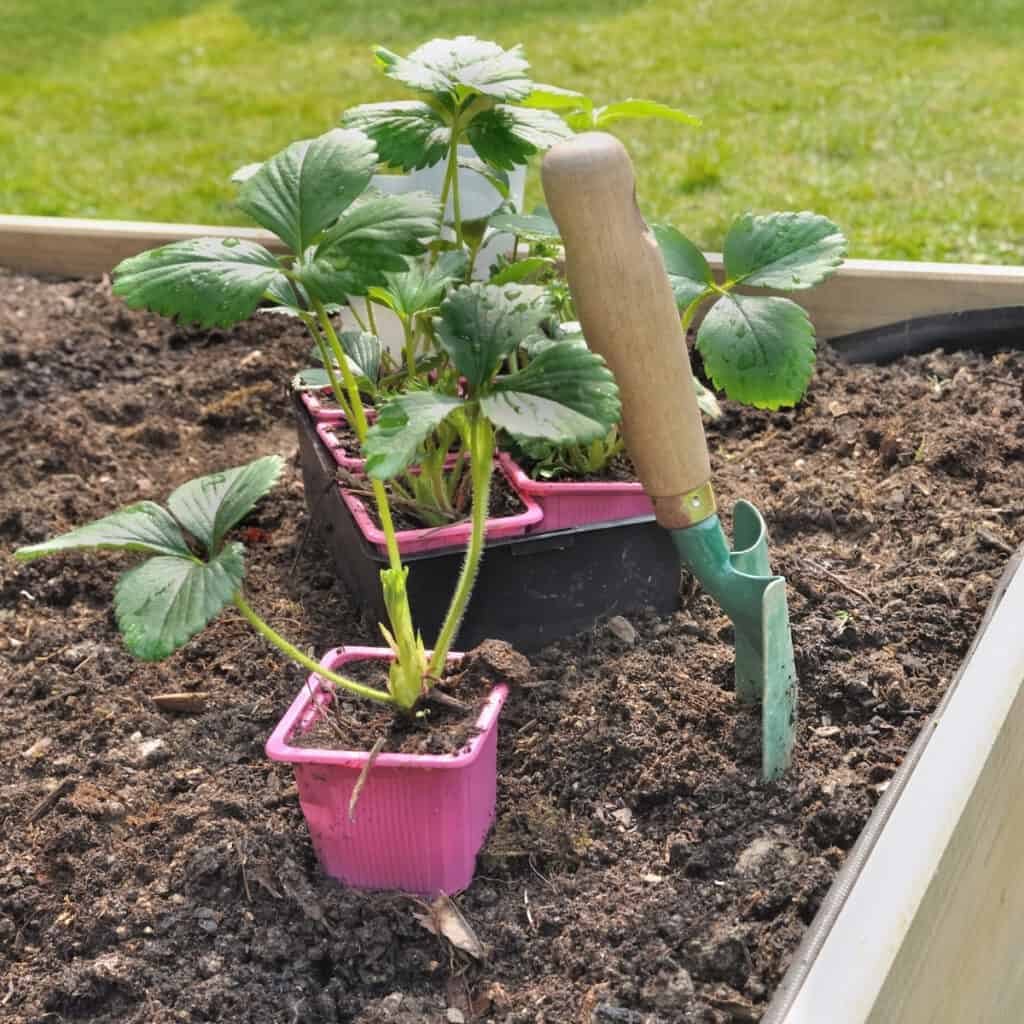
Companion plants for strawberries
Avoid areas where tomatoes, peppers, or eggplants have previously grown, as they carry a fungus called Verticillium which can attack the roots of the plants.
Plants they grow well with strawberries are:
- asparagus
- beets
- chives
- lettuce
- onions
- peas
- radishes
- spinach
- some flowers are another good option to plant with strawberries
Maintaining & caring for strawberry plants
Watering tips: Provide consistent moisture to your strawberry plants, especially during the flowering and fruiting stages. Water the plants deeply but infrequently to encourage deep root growth.
Avoid overhead watering to prevent fungal disease. If you’re able to, install a drip irrigation system to water at the base of the plants.
Mulching: Apply a layer of mulch around the strawberry plants to help retain soil moisture, suppress weeds, and keep the fruit clean. Organic mulches like straw or shredded leaves work well for strawberries.
Our favorite option is to use garden straw mulch. Be sure to source clean options that haven’t been sprayed.
Fertilizing: Fertilize the strawberry plants regularly to promote healthy growth and fruit production. Use an organic and balanced fertilizer or one formulated specifically for berries, and follow the manufacturer’s instructions for application rates.
If you’re in the garden daily, weed control and maintenance on your plants is very simple. You’ll be able to spot and fix any issues that arise quickly!
Be sure to remove any weeds that emerge in the raised bed to prevent competition for nutrients and water. Inspect the plants regularly for signs of pests or diseases, and take appropriate measures to control them.
By following these steps, you can successfully grow strawberries in a raised bed and enjoy a bountiful harvest throughout the growing season.
More Plant Growing info:
FAQ (frequently asked questions)
Depending on the variety and growth habit, some strawberries may benefit from support. This will also help keep them from rotting before you get a chance to harvest them. Install trellises or stakes to keep the plants upright and prevent the fruit from touching the ground. Consider using row covers or netting to protect the plants from birds, pests, and excessive sunlight. Remember to allow bees and other pollinators the ability to get to the strawberry flowers too.
Powdery mildew, root rot, leaf scorch, and leaf spot are common diseases that strawberry plants can experience.

